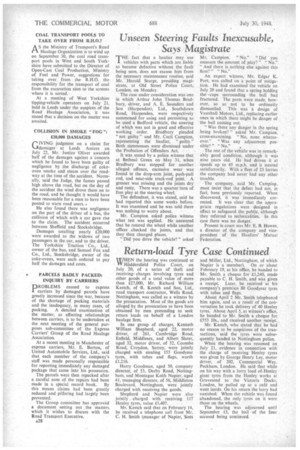Unseen Steering Faults Inexcusable, Says Magistrate
Page 30

If you've noticed an error in this article please click here to report it so we can fix it.
THE fact that a haulier may use vehicles with parts which are liable to become defective without the fault being seen, does not excuse him from the necessary maintenance routine, said Mr. Harold Sturge, presiding magistrate, at Old Street Police Court, London, on Monday.
The case under consideration was one in which Arthur John Thomas Bradbury, driver, and A. E. Saunders and Son (Harpenden), Ltd., Southdown Road, Harpenden, were respectively summoned for using and permitting to be used a Bedford vehicle, the steering of which was not in good and effective working order. Bradbury pleaded "not guilty" and Mr. Cecil Campion, representing the haulier, "guilty." Both summonses were dismissed under the Probation of Offenders Act.
It was stated by a police witness that at Bethnal Green on May 31, when Bradbury was stopped for another alleged offence, excessive wear was found in the drop-arm joint, push-pull rod, and near-side track-rod joint. A greaser was missing and the joints dry and rusty. There was a quarter turn of free play at the steering wheel.
The defendant, it was stated, said he had reported this some weeks before. It was examined and he was told there was nothing to worry about.
Mr. Campion asked police witness what test was applied. He answered that he rotated the wheel while another officer checked the joints, and that they then changed places.
"Did you drive the vehicle?" asked Mr. Campion. "No." "Did you measure the -amount of play?" "No." "And there is nothing else against this firm?" "No."
An expert witness, Mr. Edgar K. Port, was called on a point of mitigation. He had examined the vehicle on July 20 and found that a spring holding the—cups surrounding the ball had fractured. The parts were made, however, so as not to be ordinarily dismantled. This was a design of Vauxhall Motors, Ltd., replacing earlier ones in which there might be danger of the ball coming out.
"Was there any danger in the spring being broken?" asked Mr. Campion, cross-examining. "No, none whatsoever." "Was any adjustment possible?" "No."
-The rest of the vehicle was in remarkably good condition, although it wa:s nine years old. He had driven it at speeds up to 45 m.p.h. and it steered satisfactorily. With a fleet of 23 lorries the company had never had any other trouble.
The company, said Mr. Campiop, must insist that the defect had not, in fact, been previously reported. When discovered, it was immediately corrected. It was clear that the appropriate regulations were designed in effect to safeguard the public, although they referred to technicalities. In this case there was no danger.
Present in court was Mr. E. B. Howes, a director of the company and vicepresident of the Hauliers' Mutual Federation.












































































